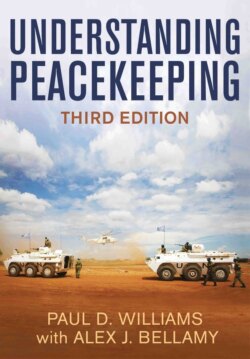Читать книгу Understanding Peacekeeping - Alex J. Bellamy - Страница 45
3.2 Non-UN peace operations during the Cold War
ОглавлениеAs already discussed, peacekeeping is not synonymous with the UN. Other actors also conducted peace operations during the Cold War. However, it is important to note that, during the entire Cold War – in stark contrast to the 1990s and beyond – there were only two UN-authorized peace operations. Both of these were small and short-lived monitoring missions, in Indonesia (1947) and Burma (1953). Non-UN missions, on the other hand, were much more common, with twenty-seven established between 1947 and 1987. Thirteen of them were small and generally short monitoring missions involving fewer than fifty personnel. But there were also some larger operations, which were conducted mainly in the Americas, the Middle East and Africa, either by regional organizations or small coalitions of states.
Despite Chapter VIII of the UN Charter, the main international problem raised by these missions was that they brought into doubt which actors had the authority to mandate peace operations (Wilcox 1965). This issue arose over Palestine in 1948 (in relation to the Arab League), Hungary in 1956 (in relation to the Warsaw Pact) and the Dominican Republic in 1965 (in relation to the OAS). The upshot of these debates was that the precise nature of the relationship between the Security Council and regional organizations remained heavily contested into the post-Cold War era (see chapter 13).
Table 3.3 provides important examples of some of the larger non-UN peace operations during the Cold War. Most were observation missions by third parties involved in brokering peace deals at the request of the belligerents. They included the deployment of Arab League peacekeepers into Kuwait in 1961 and Lebanon in 1976; the multinational joint force deployed to Cyprus in 1963, the precursor to UNFICYP; the large Inter-American force sent to the Dominican Republic in 1965; various African peacekeeping missions deployed to Zaire and Chad in the late 1970s and early 1980s; the Commonwealth force deployed in 1979–80 to assist in Rhodesia’s transition into Zimbabwe; the multinational forces deployed to Egypt (the Sinai) and Lebanon in 1982; and the deployment between 1987 and 1990 of some 53,000 Indian troops to Sri Lanka to monitor a peace accord between the Sri Lankan government and LTTE (‘Tamil Tigers’) (Rupesinghe 1989).
Table 3.3 Examples of larger non-UN peace operations, 1947–1987
Amid the ad hoc deployment of peace operations by third parties, there were also discernible signs of the development of regionalism in relation to non-UN peace operations, especially in the Americas and Africa. Recall that neither of these regions hosted many UN operations. Indeed, throughout the Cold War, only one UN mission (ONUC) was deployed in Africa and only one tiny mission (DOMREP) was deployed in the Americas. Although its involvement in the Dominican Republic in 1965 was controversial, the OAS developed a track record in deploying regional peace operations and monitors. Its role in this area began as early as 1948 with the despatch of Mexican military observers to monitor a peace accord between Costa Rica and Nicaragua. In the 1950s and 1960s, in addition to the Dominican Republic mission, the OAS oversaw peace agreements between Honduras and Nicaragua (1957), monitored the situation in Panama (1959, 1964), placed a naval quarantine on Cuba (1962), monitored the situation between Venezuela and Cuba (1963–4) and monitored a border dispute between Honduras and El Salvador (1969).
The development of regional peace operations in Africa was more chaotic, involving a wider range of actors and a number of different organizations, including the British-led Commonwealth. Nonetheless, the OAU became involved in several operations despite its strong commitment to non-interference in the domestic affairs of its members. However, it mainly provided a legitimizing framework for third-party engagement rather than conducting operations itself. In 1963, Mali and Ethiopia despatched military observers to monitor the Bamako Communiqué, negotiated under the auspices of the OAU between Algeria and Morocco. A year later, Sudan interceded in a conflict between Ethiopia and Somalia under its auspices. In 1974, the OAU created a mediation commission of inquiry to negotiate and monitor an agreement between Mali and Burkina Faso. It was also involved in the despatch of several relatively large peace operations. In 1978–9 it deployed an ‘Inter-African Force’ of 2,645 troops to assist the government in Zaire and oversee the withdrawal of Belgian and French forces, and in 1981–2 it deployed 2,600 troops to oversee the Lagos Accord in Chad.
Although some of these operations, most notably the LAS activities in the Middle East, were obviously self-serving (Collelo 1989), others made some important contributions to international peace and security and filled voids where, for one reason or another, the UN was inactive. However, they remained largely outside the UN framework and thus developed in a piecemeal fashion. One of the principal changes in peace operations after the Cold War was the growing recognition of the contribution made by regional arrangements and their increasing incorporation into the UN Charter system, either through the joint operations or through the authorization or formal recognition of the Security Council.
